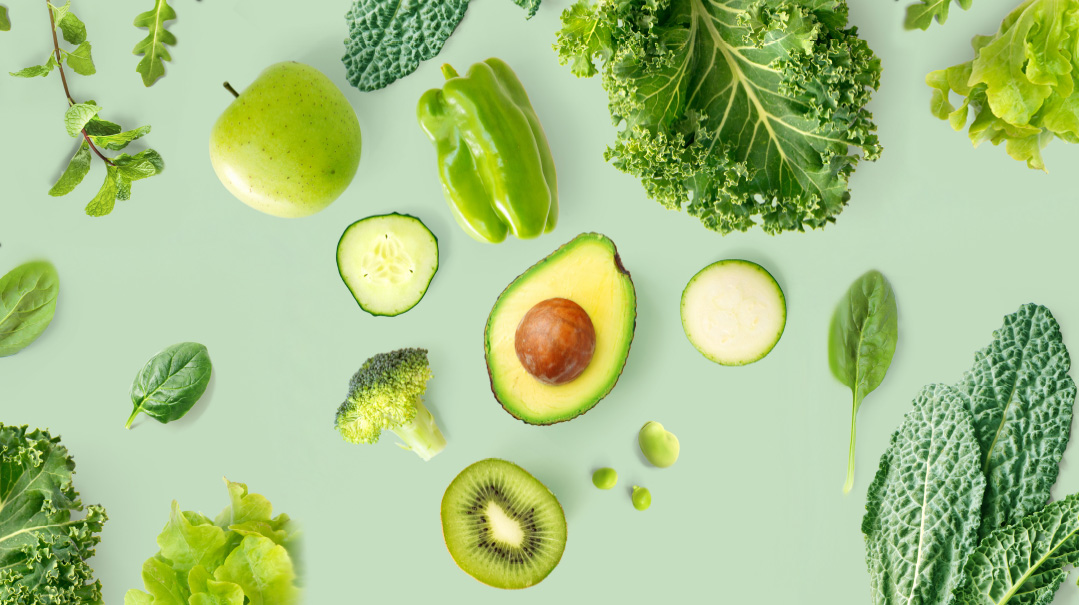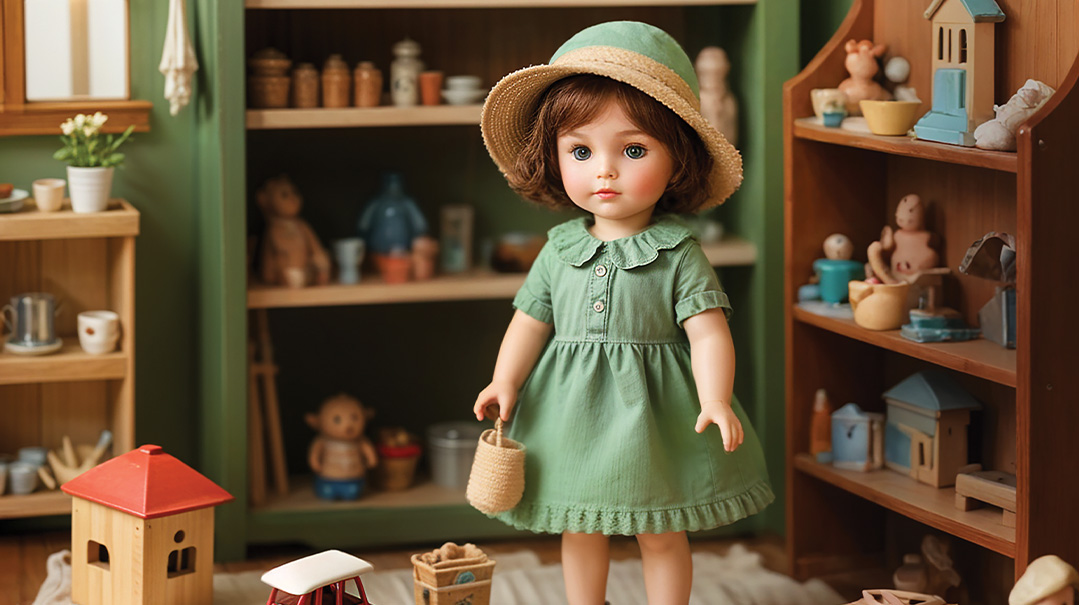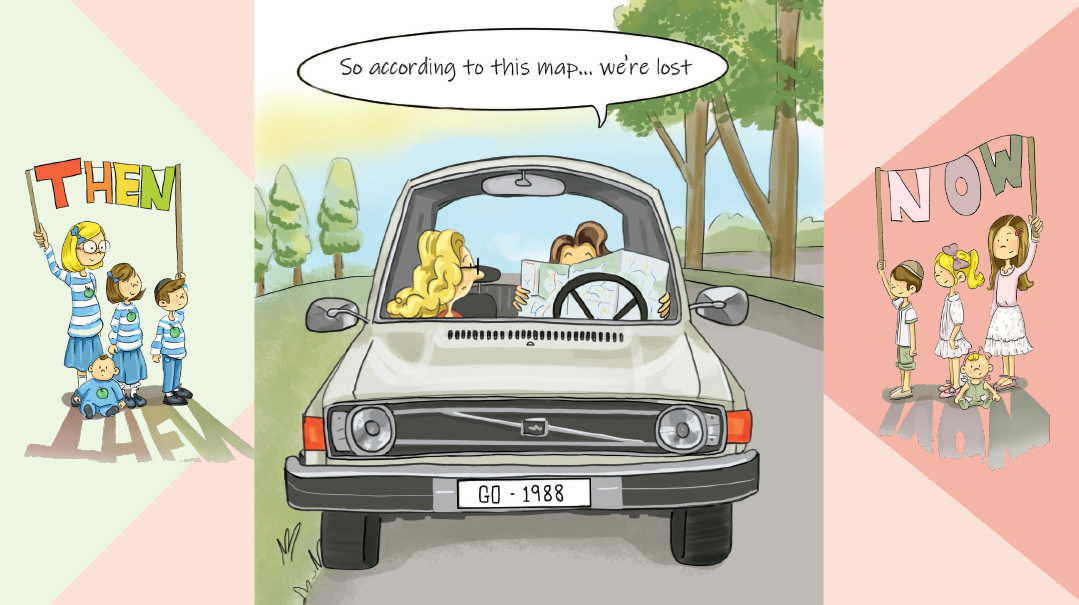Of Life Changes and Legumes

He was only getting worse, until he started eating better

It was the sort of story that could have been labeled “Medical Mystery,” tied up with a neat little diagnosis bow, and packed away with other cautionary tales. But Naama Weiss took caring for her husband’s health one step further, and today their family of 12 eats an entirely plant-based diet — Shabbos and Yom Tov included
Almost a decade ago, Levi Weiss was roughhousing with his kids on the couch when he suddenly let out a moan of pain.
It was his knee.
It was also Rosh Hashanah, but Levi stayed on the couch the rest of the Yom Tov, icing his knee and biting his tongue to keep from yelling out in pain. The Weisses were living in Ramat Eshkol, far away from family, juggling three little ones under the age of three, and they felt alone and frightened in the face of the unknown. On Motzaei Yom Tov, they reached out to Benny Fisher, the medical askan. Benny pulled some strings and got them an appointment for the following day with the head of the orthopedic department at Har Hatzofim hospital.
When the pompous doctor gave Levi’s knee a cursory glance and declared it an old basketball injury, they accepted it without question. And thus followed some of the most challenging years of the Weisses’ life. Over the next decade, Levi had flare-ups constantly. Mostly it was in his knee, sometimes his ankle, and during one fateful incident, his toe. The pain was so bad he would sit a foot away from the table to ensure none of the little kids would accidentally kick him in the leg.
“So many times,” Naama admits, “I felt entirely alone. Physically, like when he couldn’t attend shul on Simchas Torah because of a flare-up, and my kids were begging neighbors to throw them in the air during Moshe Emes, but also emotionally. Levi was the one in agony, but I felt drained, emotionally exhausted by his pain. Then there was the kidney stones episode, which we didn’t realize was related to all his other ‘injuries.’
“I needed to renew my American driver’s license, and it worked out that I’d be going to the US myself to do so… and to have a much-needed vacation. It was the first (and last!) time I’d be going by myself, and I was really looking forward to it. Then Levi walked in from shul Shabbos morning and said, ‘I think I’m having kidney stones.’ He’d actually researched kidney stones recently for a friend and recognized the signs. His chavrusa took him down to the Shabbos clinic to receive a cortisone shot for the pain, but he was still in agony. I watched my trip to America fizzle away before my eyes, and I wasn’t sure I’d be able to handle the disappointment. That’s when Levi remembered something from his research: If you drink an entire bottle of Coke in one sitting, Coke acidifies the blood, which dissolves kidney stones in 80 percent of cases. We’re into healthy eating and don’t drink Coke — like ever — but my brother had been at our house a few weeks before, and we’d bought a few bottles in his honor. I grabbed the remaining bottle, Levi sat down, and I handed him cup after cup. And the stones actually left his body. And I was able to go and renew my license and my spirits.”
Some Answers
One summer several years ago, the Weisses flew back to the States for the summer as a family. “I kept telling the kids that after Tishah B’Av, we’d take some fun road trips, really tour the country. I was expecting, but Levi was going to drive, and I was all ready to sit stretched out in the passenger seat, snacking and pointing out the sites to the kids. And then late Tishah B’Av afternoon, Levi had a flare-up in his toe. He told me he wasn’t driving anywhere anytime soon. And I broke. I was heavily pregnant, I was tired, and I was hot. There was no way I was traipsing up and down the highway with a car full of kids. I started to cry. Levi shared with his parents what was going on, saying he didn’t even remember ever injuring his toe, and then Levi’s father said the very casual words that would change our lives forever: ‘That’s gout.’”
Gout.
Not a knee injury. Not some yeshivah boy basketball star souvenir. Gout.
Gout occurs when urate crystals accumulate in your joints, causing inflammation and intense pain. Urate crystals can form when you have high levels of uric acid in your blood. The body produces uric acid when it breaks down purines. And kidney stones are often caused by uric acid crystals.
“The signs were all there, but we were so focused on the head of the orthopedic department’s diagnosis, we didn’t think to connect the dots. It took us almost ten years from the first knee flare-up to figure it out. Gout usually effects older men, and our saga began when my husband was in his late twenties. Gout attacks usually affect the big toe, but since Levi’s attacks mostly showed up in his knee or occasionally the ankle, and that top doctor had diagnosed it as an old sports injury, we really believed it was tight muscles or the old injury and we never questioned further.”
“The good part,” Levi’s father said cheerfully, “is that gout sufferers just take Allopurinol and feel as good as new.”
It sounded miraculous. Levi began the Allopurinol, and as all gout sufferers know, he stayed away from red meat and alcohol. (Gout has been called the disease of kings, because years ago, only kings could afford the sorts of food that cause flare-ups.) The Weisses began centering their meals around dairy. “I was excited,” Naama says. “I love dairy. I was making these gorgeous cheesy omelets and delicious quiches. And the gout was getting worse. He was on three different medications, but the flare-ups were worse and more frequent than ever and no one had answers, because medication works for almost everyone.”
So Levi went on a research dive. An avreich for many years, he used his gemara kup to learn all he could on the topic. His research led him to relief in the form of whole foods and plants. He discovered that cherries contain more anti-inflammatory properties than Advil. He started drinking a cherry shake every night, but it only seemed to be mildly helping. He read that when the body doesn’t fully break down protein, it produces a lot more uric acid. Since animal-source protein is harsher on the liver and kidneys, and more difficult to digest, he hypothesized that a plant-based diet would help heal his suffering.
The research was all right there, the answers just lying beneath the surface. But because no one actually needed to do the research, because the Allopurinol worked so well for them, he was in uncharted territory.
A talmid chacham close with the Weisses told them about a book written by a doctor that his rebbi holds highly of, about plant-based eating. “The briah holds unbelievable yeshuos if we just allow them in,” he told them. And so on Erev Rosh Hashanah, full circle from that fateful Rosh Hashanah almost a decade before, when Levi’s knee first started to hurt, Levi turned to Naama and said, “I want to switch over to a whole-foods, plant-based diet. I think it will truly eradicate this terrible pain from my life. I don’t want to feel like this anymore. I want to live and feel young and raise my children without being afraid they’ll kick my leg or I’ll be incapacitated during the next big family moment.”
Naama looked at him. There was a two-day Yom Tov ahead, with myriad guests lined up for each meal, not to mention the Weisses then brood of eight. “I told him I couldn’t do it,” she says simply. “It was too daunting. Succos was around the corner, not to mention Yom Kippur seudahs before and after. I needed to make chicken, meats. Hearty, delicious Yom Tov foods, recipes I know and can turn out in my sleep. I needed the ease of one-pan roasts and crispy kugels. I couldn’t do this. Not then.”
Levi has always valued health, and so although Naama has been baking since she was 12, she gave up white sugar, white flour, and margarine shortly after they married. “I felt like I had mastered cooking and baking healthily. But this was a new level. I was scared to even try. I just wanted to be like everyone else — I didn’t want this new challenge.”
Levi understood, and he didn’t want to pressure her. All he said was, “I don’t want to be sick anymore — stuck in the house and in so much pain. I feel like I’ve tried everything else and this can be so simple. I need to just jump in so I can live normally again. Don’t you want that as well?”
“He was right,” Naama says. “I wanted him healthy and alive, at my side, for as long as possible. So I did it. I cooked regular food for me and the kids, and I made plant-based dishes for Levi. And something interesting began to happen. Levi, who usually gets sick every winter, was healthy as a horse. No strep, no flu, and no gout. The kids could bang his leg, and he was fine, baruch Hashem. It was incredible to see. I, on the other hand, was expecting my ninth, and my blood pressure was through the roof. That’s when Levi said, ‘You know, Nam, plant-based diets can lower blood pressure… do it with me.’ I had nothing to lose. I was cooking anyway, so I did. After I gave birth, my blood pressure was a perfect 110/70. It was incredible. I felt incredible. And I realized I was done with other foods. I was all in.”
Naama kept cooking regular food for the children though; as a stay-at-home mom, she cooks three square meals a day. “I have one child I made schnitzel for every single day. That’s what he wanted. We had discussions on why we were eating plant-based and what happens in your body when you eat other foods. But there was no pressure and gradually, the kids asked to taste our food. They loved it; rice with fried beans, portobello mushroom steaks, homemade ice cream, etc. Bit by bit, they stopped eating the ‘other’ foods. After a while, they told me to stop making the other food altogether.”
And that’s how the Weiss family of 12 came to follow an exclusively whole-foods, plant-based diet.
“Our society is very food-based,” Naama says, “and I tell my kids that we don’t want to be lifrosh min hatzibbur. We do this because it’s a statistically healthier way to live and helps us better serve Hashem.”
Aside from a total improvement in Levi’s gout and Naama’s blood pressure, the family has seen many other health perks. “My kids don’t get sick,” Naama shares. “Other moms joke about living at the pediatrician, and I just nod and smile. Thank G-d, I can count on one hand which kids have had antibiotics and why. If they get sick, it’s usually only for a few hours, and all they need to do is rest on the couch.”
Naama encourages her kids to eat what they want. “If there’s a pizza party or a barbecue siyum, I tell them, go for it! But they honestly don’t want to. It doesn’t even look good to them. One kid ate Yerushalmi kugel on a class trip and felt queasy afterward. I have a daughter who started eating this way because she started breaking out when she ate dairy and eggs. They don’t want the pizza. But because I don’t restrict them, they feel completely free to make smart decisions, unclouded by the need to sneak behind our backs or to defy our family’s choices.”
The entire family is all in; wherever life takes them: seminary, yeshivah, camp, or home.
Behind the Scenes
Eating this way often involves advanced planning and creativity. But it’s important to the kids and it’s important to Naama; she’ll go the extra mile making special foods to send with them. “Some of them don’t want others to know what they eat, and some share it with the world. But either way we support them and are proud of them.”
As Naama said, we’re a society rooted in food traditions. But more than that, we have so many moments in our lives centered around food. How do the Weisses marry both halachah and hashkafah with their food choices? And how do they fend off the naysayers and skeptics who are quick to write off such a lifestyle as hashkafically unsound?
“In the beginning, there was definitely a part of me that second guessed our decision, so we asked our rav, but I still struggled with it hashkafically,” Naama says. “So in true Weiss manner, I did research. And I discovered so much beautiful information. First, Shlomo Hamelech wrote a Sefer Harefuos. Chizkiyahu hid it away, scared it would lessen bitachon in Hashem, but the point of the sefer was to recognize that all refuos are from HaKadosh Baruch Hu, and they’re all in the briah already, scattered throughout Creation. So hishtadlus for health can include using Hashem’s creations to maintain health. The Rambam in Hilchos Yesodei HaTorah (4:20) says he guarantees that anyone who follows his instructions for healthy living will never come to sickness until they’re old, and will die without needing a doctor. The point is that there’s a way to keep our bodies healthy by eating and drinking and sleeping properly.
“My husband points out that if someone goes to a doctor, gets put under anesthesia, cut open, has an artery unclogged and some artificial stents put in, then it’s considered hishtadlus — important, wise hishtadlus. But if someone changes their entire diet, people call them drastic. Rav Shimshon Pincus says Hashem is tov and shalem, and the more shalem a food is, the more tov it is. And the Rambam says a person has a chiyuv to have a healthy body to serve Hashem.”
Naama does use some processed foods for the kids, such as using pareve meats and cheeses to recreate some kid-friendly dishes, not to mention cholent and kishke. Her Shabbos menu looks the same as mine or yours; you’d be hard put to realize it’s all pareve.
And what about basar vedagim on Shabbos and Yom Tov?
Naama shrugs. “Chazal only say to eat a k’zayis — and eating l’Sheim Shamayim will never hurt you. But nowhere does Chazal say anything about eating basar vedagim during the week. And definitely nothing about laying out five different meats every Shabbos meal — it’s hard to say that that’s really l’Sheim Shamayim. Today, we eat in a way our ancestors never ate and get sick in a way our ancestors never got sick. So many health issues that are rampant today barely existed generations ago. Hashem built the whole world for us. And we foolishly take it apart. When white rice was first marketed, the manufacturers took the husk off, which removed many of the vitamins it contains, and millions of people died in the 19th century from beriberi, a vitamin B-deficiency disease. Today, white rice is fortified with vitamins to compensate for the vitamins lost in the refinement process. But Hashem created foods with every nutrient our bodies need.
The family’s commitment to this lifestyle is continually reinforced by constant newfound benefits. “As opposed to when Levi was unwell, I didn’t even realize how much it affected his mood and personality until I contrast it with the person he is today. I accepted so much. He lived with so much,” Naama says. “Anyone who would try eating this way for even a few weeks would see the benefits.”
A major plus as well, Naama adds, is that with foods rich in fiber, you get full much more quickly. “My friend has 11 children, and she makes three cups of white rice a meal. And her kids aren’t full. I make half the amount of brown rice, and we’re bursting. Even though protein does give you the feeling of being full, it doesn’t fill you like fiber does. There’s also the added bonus that fiber-rich fruits and veggies are fat-free. Not to mention the benefits of certain extra power-packed foods, such as flaxseed. I have so much energy, and with my full house, I need that.
Naama shares one last story. “My friend’s husband was very ill with the machalah. He had weeks left, since it had spread. He wasn’t eating any longer, yet was too weak to begin chemo. The situation was desperate and my friend was slowly breaking. So I sent over a hot dinner, because that’s what a Jewish woman does when someone’s in pain. It was my specialty Spanish rice and refried beans, a little comfort food. And her husband, Shmuel, smelled it and asked if he could eat some. For the first time in days, he put food in his mouth. And then he wanted more. And then more. He began eating, and gained back some of the energy necessary to pull him from death’s door. And that led to a renewal to live. The food was so good for his body, he started to feel better and stronger. The results were amazing, and the doctors and askanim were astonished. They both told him, ‘Whatever you’re doing, keep doing it.”
“I gave my friend some cooking demos so she could make him the food he craved. It was an uncommon hishtadlus, but sometimes that’s all Hashem needs from us to send us the yeshuos we so desperately need. Hashem created an amazing body, and the less we interfere with it, the more goodness can result. We just need to leave room to see the chochmah He put into our bodies. If we treat our body right, we allow Hashem to heal us.”
Vegan vs. Plant-based
Veganism is a religion with a postulate that is completely incongruous with Torah, premised on animal treatment being equal to people, chas v’shalom. Whole-food, plant-based eating is about using the brios Hashem created to strengthen ourselves to be as healthy as possible.
Recipes
This is my favorite dinner. It’s super easy and pleases a lot of people, old and young.
Spanish Rice
- 2 cups short-grain brown rice
- 5 cups water
- 2 tablespoons oil
Put all the ingredients into a pot and simmer on low for 45 mins or until all the water evaporates.
Put one large onion, one medium pepper of any color, and one cup water in a separate pot. Cook over medium heat until the water evaporates. Mix in the cooked rice and 240 grams of tomato paste. Add salt, pepper, and garlic powder to taste.
Refried Beans
Just empty a 15.5 oz. can of refried beans, liquid included, into a frying pan, and cook on medium heat for about ten minutes, until the liquid thickens.
Serve with guacamole, corn, corn chips, and taco sauce of your choice. I sometimes sauté a meat substitute as well.
(Originally featured in Family First, Issue 848)
Oops! We could not locate your form.







